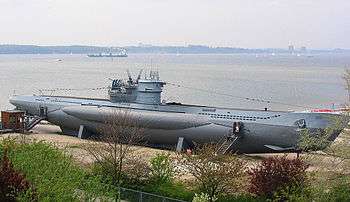German submarine U-1007
 U-995 Type VIIC/41 at the Laboe Naval Memorial. This U-boat is almost identical to U-1007. | |
| History | |
|---|---|
| Name: | U-1007 |
| Ordered: | 23 March 1942 |
| Builder: | Blohm & Voss, Hamburg |
| Yard number: | 207 |
| Laid down: | 15 February 1943 |
| Launched: | 8 December 1943 |
| Commissioned: | 18 January 1944 |
| Fate: | Scuttled on 2 May 1945 |
| Status: | Broken up May 1946 |
| General characteristics | |
| Type: | Type VIIC/41 submarine |
| Displacement: |
|
| Length: |
|
| Beam: |
|
| Height: | 9.60 m (31 ft 6 in) |
| Draught: | 4.74 m (15 ft 7 in) |
| Installed power: |
|
| Propulsion: |
|
| Speed: |
|
| Range: | |
| Test depth: |
|
| Complement: | 44-52 officers & ratings |
| Armament: |
|
| Service record | |
| Part of: |
|
| Commanders: | |
| Operations: | 1 patrol |
| Victories: | None |
German submarine U-1007 was a Type VIIC/41 U-boat of Nazi Germany's Kriegsmarine during World War II.
She was ordered on 23 March 1942, and was laid down on 15 February 1943 at Blohm & Voss, Hamburg, as yard number 207. She was launched on 8 December 1943 and commissioned under the command of Oberleutnant zur See Hans Hornkohl on 18 January 1944.[6]
Design
German Type VIIC/41 submarines were preceded by the heavier Type VIIC submarines. U-1007 had a displacement of 769 tonnes (757 long tons) when at the surface and 871 tonnes (857 long tons) while submerged. She had a total length of 67.10 m (220 ft 2 in), a pressure hull length of 50.50 m (165 ft 8 in), an overall beam of 6.20 m (20 ft 4 in), a height of 9.60 m (31 ft 6 in), and a draught of 4.74 m (15 ft 7 in). The submarine was powered by two Germaniawerft F46 four-stroke, six-cylinder supercharged diesel engines producing a total of 2,800 to 3,200 metric horsepower (2,060 to 2,350 kW; 2,760 to 3,160 shp) for use while surfaced, two BBC GG UB 720/8 double-acting electric motors producing a total of 750 metric horsepower (550 kW; 740 shp) for use while submerged. She had two shafts and two 1.23 m (4 ft) propellers. The boat was capable of operating at depths of up to 230 metres (750 ft).[7]
The submarine had a maximum surface speed of 17.7 knots (32.8 km/h; 20.4 mph) and a maximum submerged speed of 7.6 knots (14.1 km/h; 8.7 mph). When submerged, the boat could operate for 80 nautical miles (150 km; 92 mi) at 4 knots (7.4 km/h; 4.6 mph); when surfaced, she could travel 8,500 nautical miles (15,700 km; 9,800 mi) at 10 knots (19 km/h; 12 mph). U-1007 was fitted with five 53.3 cm (21 in) torpedo tubes (four fitted at the bow and one at the stern), fourteen torpedoes or 26 TMA or TMB Naval mines, one 8.8 cm (3.46 in) SK C/35 naval gun, 220 rounds, and an anti-aircraft gun. The boat had a complement of between forty-four and fifty-two.[7]
Service history
U-1007 participated in one war patrol which resulted in no ships damaged or sunk.[6]
On 2 May 1945, U-1007 was in the Trave River north-east of Lübeck, 53°54′N 10°50′E / 53.900°N 10.833°ECoordinates: 53°54′N 10°50′E / 53.900°N 10.833°E, when she was attacked by four Hawker Typhoon's of the 245th Sqn RAF piloted by F/Lt F.S. Murphy, F/O F.J. Pearson, W/O K.D. Woddan, and F/Sgt C.M. Brocklehurst. The rockets from the Typhoons badly damaged U-1007 forcing her crew to beach and scuttle her. Two of the crew died from the attack, one during and another of wounds in a hospital.[6]
The wreck was raised in May 1946 and broken up.[6]
See also
References
- ↑ Helgason, Guðmundur. "Hans Hornkohl". German U-boats of WWII - uboat.net. Retrieved 19 March 2016.
- ↑ Helgason, Guðmundur. "Leonhard Klingspor". German U-boats of WWII - uboat.net. Retrieved 19 March 2016.
- ↑ Helgason, Guðmundur. "Helmut Wicke". German U-boats of WWII - uboat.net. Retrieved 19 March 2016.
- ↑ Helgason, Guðmundur. "Karl-Heinz Raabe". German U-boats of WWII - uboat.net. Retrieved 19 March 2016.
- ↑ Helgason, Guðmundur. "Ernst von Witzendorff". German U-boats of WWII - uboat.net. Retrieved 19 March 2016.
- 1 2 3 4 Helgason, Guðmundur. "U-1007". German U-boats of WWII - uboat.net. Retrieved 19 March 2016.
- 1 2 Gröner 1991, pp. 43-44.
Bibliography
- Busch, Rainer; Röll, Hans-Joachim (1999). German U-boat commanders of World War II : a biographical dictionary. Translated by Brooks, Geoffrey. London, Annapolis, Md: Greenhill Books, Naval Institute Press. ISBN 1-55750-186-6.
- Busch, Rainer; Röll, Hans-Joachim (1999). Deutsche U-Boot-Verluste von September 1939 bis Mai 1945 [German U-boat losses from September 1939 to May 1945]. Der U-Boot-Krieg (in German). IV. Hamburg, Berlin, Bonn: Mittler. ISBN 3-8132-0514-2.
- Gröner, Erich; Jung, Dieter; Maass, Martin (1991). U-boats and Mine Warfare Vessels. German Warships 1815–1945. 2. Translated by Thomas, Keith; Magowan, Rachel. London: Conway Maritime Press. ISBN 0-85177-593-4.
External links
- Helgason, Guðmundur. "Patrols by U-1007". German U-boats of WWII - uboat.net.